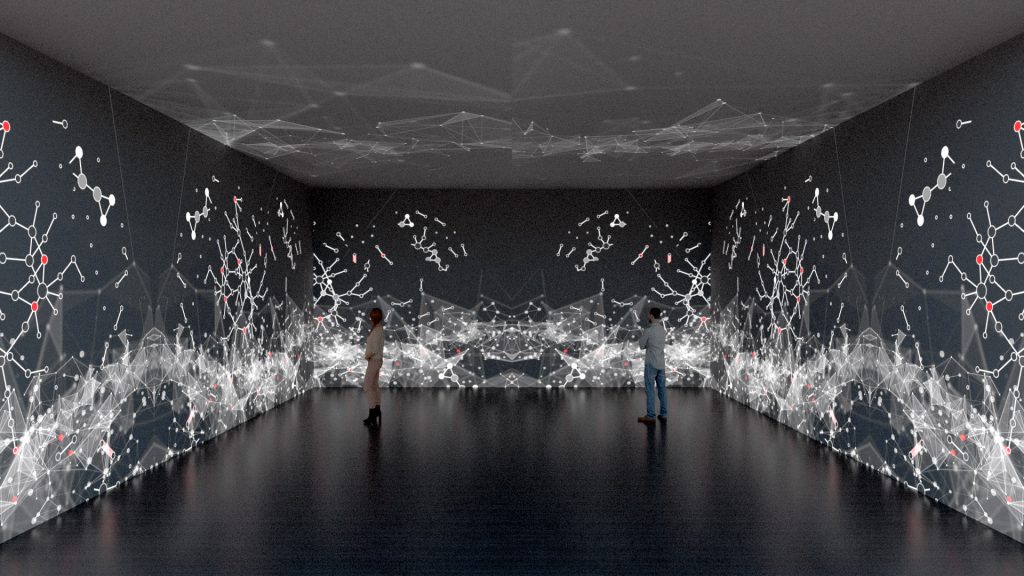Artists: Yiannis Kranidiotis, Sam Nester, Giovanni Paolo Randazzo
Scientists: Alba Bernini, Ana Montero Castaño, Irene Guerrero Fernandez

“Anthos” is commissioned by the European Commission’s Joint Research Centre as part of the SciArt Resonances IV program.
Anthos is an immersive, interactive sound and light installation that highlights the importance of pollinators and demonstrates our anthropogenic effect on them. With a goal to uncover potentially hidden secrets about the plant-pollinator network and its functions, this installation is designed on the principles of complex theory. Audiences to Anthos step into an ever-changing data visualisation/sonification model of pollinator systems projected on all walls. Sensors throughout the museum register changes in environmental parameters, such as fluctuations in CO₂, which affect how the network behaves. The changing audio and visual outcome, along with projected live data from the sensors, demonstrates ways in which the climate crisis is putting ever more strain on this natural and fragile system.
Exhibitions:
Description
Visitors to Anthos will enter a space teeming with projected visualisations of a digital model, based on a complex system demonstrating plant-pollinator networks. The system controlling the space calculates and generates visuals and audio in real-time as visitors explore the installation. A CO₂ and temperature/humidity sensor are placed inside the museum, tracking changes in these parameters, which in turn affect the complex system being projected inside Anthos, according to European biodiversity models. This live data, along with its effects on a scaled version of the plant-pollinator network, are visible and audible to the audience.

Multiple projectors are used to create the immersive visual field, covering the walls and ceiling of the space. Loudspeakers at multiple locations within the room are used create a surround sound experience, allowing participants to follow specific locations of change within the system.
Concept
In Michel Serres’ 1990 work Le contrat naturel, he discusses making peace with the world in order to save ourselves. In order to make peace, we must first find a unified language in which to commune with nature. Anthos aims at finding this unified language through an extensive study of pollination networks, extracting principles for the creation of this generative, interactive sound and light installation that amplifies this complex and yet fragile natural system. As we look toward balancing the sheet on human/non-human relationships, it is critical that we examine the systems we are aiming to repair if we are to turn the tide on climate change and achieve the ambitious European Green Deal.
Plant-pollinator interactions do not occur in isolation but are embedded in complex interaction networks. Researching the intimate and intricate network of relationships in plant-pollinator communities holds the potential of understanding not only their functioning, but also our broad effects on such intricate systems, which is the result of co-evolutionary processes. Plant-pollinator interactions can be described referring to the theory of complexity.
In general, a complex system is a collection of many components locally interacting with each other and with their environment. Through interactions, a complex system can spontaneously self-organise, producing collective behaviour without an initial plan and central authorities or leaders. There is no controlling entity, whether central or external, but ‘control’ is distributed among components and integrated through interactions between them.
The properties of the whole system cannot be understood or predicted from the full knowledge of its constituents alone and their connections. In other words, ‘the whole is more than the sum of its parts’ and we can only observe the emergent behaviour of the system, produced by the interacting components. In nature, complex systems have multiple scales of organisation.
Pollination systems can be illustrated as complex systems, whose components are pollinator and plant species, connected thanks to their mutually beneficial interactions. The complexity arises from several sources, including the sheer abundance of plants and pollinators (in both numbers and species), the richness of the interactions between individuals and populations of different species, the wide variations in environmental conditions that affect both organisms and their interactions.